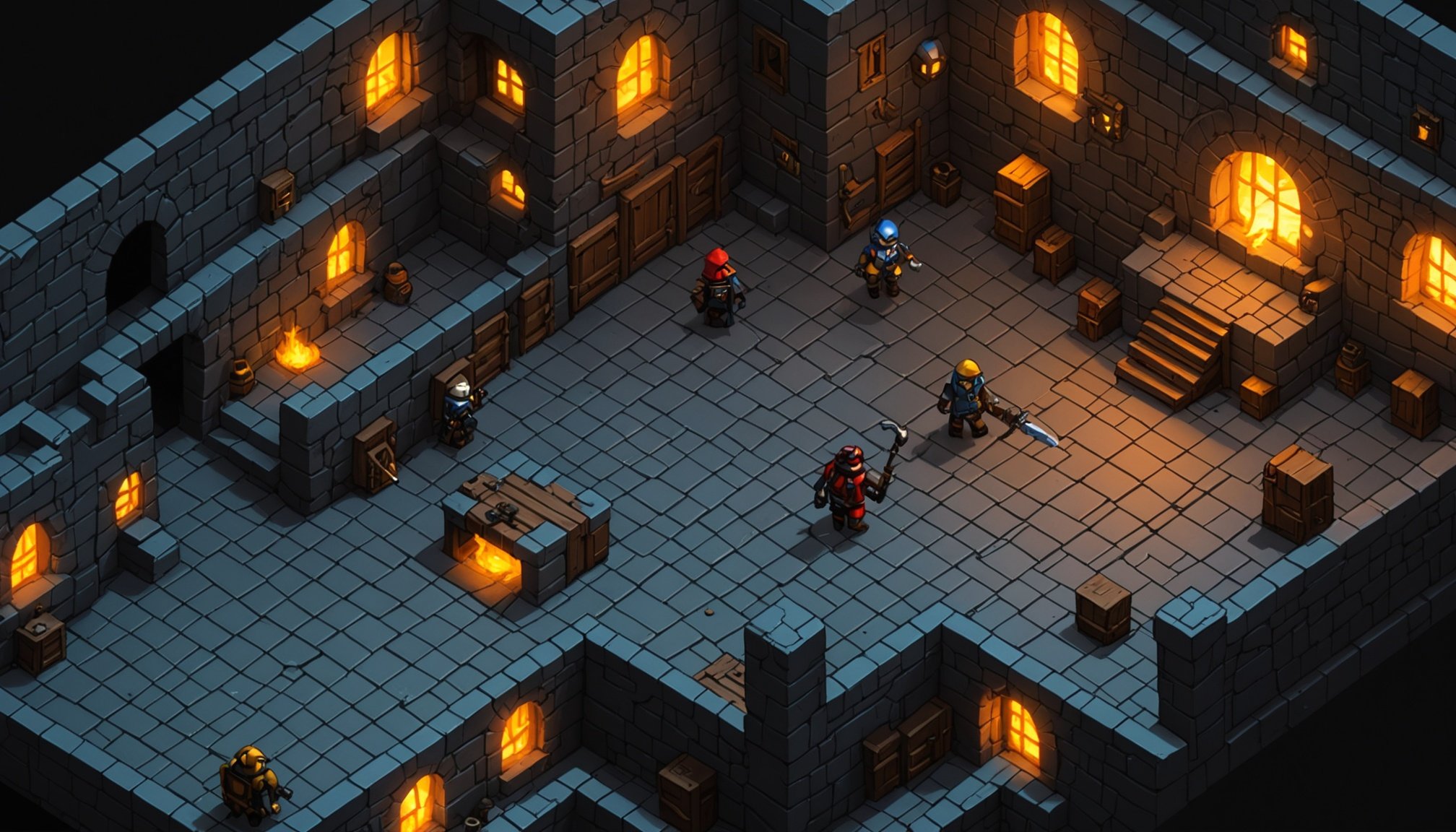Transforming Roguelike Game Design Through Machine Learning: Unleashing the Power of Procedural Creativity
What is Procedural Generation?
Procedural generation is a technique that has revolutionized the way games are developed, particularly in the roguelike genre. This method involves creating content on the fly using algorithms, rather than relying on pre-designed elements by humans. In the context of roguelike games, procedural generation can create levels, enemies, items, and even entire worlds, offering virtually endless variety and replayability[1][2].
Key Components of Procedural Generation
- Algorithms: These are the specific procedures or formulas designed to automate the creation process. For example, algorithms like L-System, Perlin Noise, and Cellular Automata are commonly used to generate diverse content[2].
- Randomness: This introduces variability and uniqueness into the generated data, ensuring that each playthrough is different.
- Constraints: These are the rules or parameters that ensure the generated data remains within the desired boundaries of the game’s design.
The Role of Machine Learning in Procedural Generation
Machine learning is increasingly being integrated into procedural generation to enhance the creativity and adaptability of game content. Here’s how it works:
Topic to read : Elevating Augmented Reality Gaming: Harnessing Neural Networks for Instant Object Recognition
Learning from Data
Machine learning models can be trained on existing game data, such as level designs, enemy behaviors, and player interactions. By analyzing this data, the models can identify patterns and generate new content that fits within the game’s design parameters. For instance, a game like Hades could use machine learning to generate new levels that are as challenging and engaging as those designed by human developers[1].
Dynamic Adaptation
One of the most exciting aspects of machine learning in procedural generation is its ability to adapt to player behavior. A game can use machine learning to adjust the difficulty level, enemy spawn rates, or even the layout of levels based on how the player is performing. This dynamic adaptation ensures that the game remains challenging but not overwhelming, enhancing the overall player experience.
Also to read : Unlocking Enchanted Forest Realms: Essential Tactics for Crafting Engaging Exploration Adventures
### Examples of Dynamic Adaptation
- **Difficulty Adjustment:** The game can increase or decrease the difficulty based on the player's performance.
- **Enemy Spawn Rates:** The frequency and type of enemies can be adjusted in real-time to keep the game challenging.
- **Level Layout:** The layout of levels can be modified to present new challenges or opportunities based on player behavior.
Case Studies: Successful Integration of Machine Learning
Into the Breach
Into the Breach, developed by Subset Games, is a prime example of how procedural generation can be used effectively in roguelike games. Here’s how it works:
- Turn-Based Tactics: The game involves controlling giant robots to fight against an alien invasion on 8×8 grid levels, each with its own unique challenges and objectives.
- Machine Learning Potential: While Into the Breach does not explicitly use machine learning, it demonstrates the potential for integrating such technologies. Imagine if the game could use machine learning to analyze player strategies and adapt the level generation accordingly. This could include generating levels that exploit common player mistakes or creating scenarios that require innovative solutions[1].
Hyper Light Breaker
Hyper Light Breaker, an open-world roguelike game developed by Heart Machine, solves the “impossible problem” of combining open-world exploration with roguelike gameplay. Here’s how they achieved it:
- Procedural Open World: The game generates a new world for each run, allowing players to spend hours exploring but ensuring that each run is short enough to be completed in a reasonable time.
- Extraction Mechanics: The team used extraction mechanics to capture the feeling of an open-world game and the highs and lows of a roguelike game, decoupling the scale of the world from a run[3].
Practical Insights and Actionable Advice for Game Developers
For game developers looking to incorporate machine learning into their procedural generation systems, here are some practical insights and actionable advice:
Start with Existing Data
Begin by collecting and analyzing existing game data. This could include level designs, player interactions, and game metrics. Use this data to train your machine learning models to generate content that is consistent with your game’s design.
Use Reinforcement Learning
Reinforcement learning is a type of machine learning that involves training models to make decisions based on rewards or penalties. This can be particularly useful in procedural generation, where the model can be rewarded for generating content that is engaging and challenging.
Balance Complexity and Simplicity
While machine learning can generate highly complex content, it’s important to balance this with simplicity. Ensure that the generated content is understandable and enjoyable for the player. A good example is Peglin, which blends roguelite gameplay with pachinko-style challenges in a way that is both simple to understand and deeply engaging[1].
Community Engagement and Feedback
Games are starting to incorporate community feedback into their procedural generation systems. Here’s how this can enhance the gaming experience:
Analyzing Player Reviews
Using machine learning to analyze player reviews and feedback can help generate content that better meets player expectations. This not only improves the game but also fosters a sense of community involvement.
Tailoring Content to Player Preferences
By analyzing player behavior and feedback, games can generate levels, enemies, and items that are tailored to the players’ skills and playstyles. This makes the game more dynamic and challenging, as seen in games like Deep Rock Galactic[1].
Examples of Machine Learning in Video Games
Here are a few examples of how machine learning is being used in video games to enhance procedural generation:
| Game | Key Feature |
|---|---|
| Remnant 2 | Procedurally generated dungeons with adaptive difficulty |
| Deep Rock Galactic | Unique levels generated for each mission, tailored to player skills |
| Hades | Machine learning-generated levels based on player performance |
| Into the Breach | Potential for machine learning integration to adapt level generation |
The Future of Procedural Generation and Machine Learning
As the technology continues to evolve, we can expect even more innovative and immersive gaming experiences. Here are some trends and predictions:
Advanced AI-Driven Storytelling
Procedural generation is not limited to terrain and environments; it can also be used to create narrative experiences that differ drastically each time a game is played. Games with algorithmically driven quests can offer different storylines and outcomes based on player actions and algorithmically generated events[2].
Enhanced Player Agency
The use of machine learning and procedural generation allows for greater player agency in storytelling. Similar starting points can lead to entirely different endings or experiences depending on the procedural backdrops, elevating the player’s role in shaping the game’s narrative[2].
Industry Impact
The integration of machine learning into procedural generation is transforming the gaming industry. It allows for:
- Reduced Development Time: By automating content creation, developers can focus on refining core gameplay elements.
- Enhanced Replayability: Randomly generated worlds provide new experiences each time a game is played, encouraging players to revisit.
- Increased Creativity: Machine learning can generate content that is as creative and engaging as that designed by human developers[2][4].
Procedural generation, enhanced by machine learning, is revolutionizing the way we experience roguelike games. By offering endless variety and dynamic adaptation, these games ensure that each playthrough is unique and engaging. Whether you’re a seasoned gamer or a game developer, understanding the power of procedural generation and machine learning can open up new worlds of creativity and enjoyment.
As Michael Clark from Heart Machine noted, “We wanted you to spend hours with each procedurally generated world, but we wanted a run to be short enough that you could do a few in an hour.” This balance between depth and accessibility is what makes games like Hyper Light Breaker so compelling[3].
In the end, the future of game design is not just about creating content; it’s about creating experiences that are tailored, dynamic, and endlessly engaging. With machine learning at the helm, the possibilities are limitless, and the magic behind the scenes is what makes each adventure so uniquely yours.
Future Directions in Procedural Generation and Game Design
Exploring the future of game design, trends in procedural generation reveal significant potential for transforming gaming experiences. As technology evolves, game developers anticipate advancements that will bring even more dynamic and expansive environments.
The evolution of procedural generation techniques points towards more sophisticated algorithms that could simulate natural phenomena with even greater accuracy. This progress allows for the creation of even more realistic worlds, enhancing immersive gameplay. New approaches in procedural algorithms can ensure that each player’s journey remains unique, fostering continued exploration and engagement.
The potential impact of AI advancements extends beyond just environmental enhancements. As AI technology becomes more integrated, it can facilitate more nuanced NPC interactions and storylines, creating rich narratives that adapt dynamically. This offers players the chance to engage with evolving plots and character developments that react to their decisions.
Emerging trends in roguelike game design are steering towards seamless integration of AI and machine learning for deeper complexity without compromising accessibility. By merging intelligent systems with traditional game mechanics, future roguelikes are expected to offer a blend of engagement, strategy, and unpredictability, captivating players with ever-evolving challenges and opportunities. These advancements promise to continually reshape the landscape of gaming.











